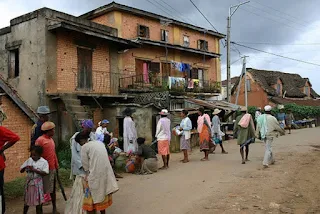Madagascar Earthquakes and Volcanoes
Madagascar's volcanoes have not erupted in 80 million years however Madagascar experiences many earthquakes every year.
Madagascar is geologically complex. Madagascar was originally part of the ancient supercontinent Gondwana, or Gondwanaland and was formed in two major steps. Madagascar west coast was formed when Africa broke off from the supercontinent Gondwana around 165 million years ago.
The thinned crust on the west coast sagged and the dips filled with sediments, forming deep basins of sedimentary rocks. Then, about 90 million years ago, when the mini-continent migrated, brief but voluminous eruptions covered the island in lava. Madagascar finally broke off from India about 88 million years ago.
Volcanoes of Madagascar
A volcano is an opening in the Earth's surface from which gas, hot magma and ash can escape from deep within the Earth.
|
Madagascar Volcanoes
|
|
|
Name
|
Height
|
|
Ankaratra Field
|
8,674 feet tall
|
|
Ankaizina
|
9,442 feet tall
|
|
Itasy Volcanic Field
|
5,905 feet tall
|
|
Ambre-Bobaomby
|
4,839 feet tall
|
|
Nosy-Be
|
702 feet tall |
Earthquakes in Madagascar
The January 12, 2017 earthquake occurred just after 1 a.m. Madagascar local time, felt in Antananarivo, Antsirabe and the Atsimo-Andrefana region. The earthquake was the eighth largest earthquake in Madagascar's geological history. The strongest earthquake to strike Madagascar happened 68 years ago recording a 6.2.
An earthquake happens when two wedges of the earth suddenly slip past one another shaking the surface of the Earth, resulting from the sudden release of energy in the rigid, rocky outer layer of the Earth creating seismic waves.
|
Registered Earthquakes in Madagascar in the past 10 years
|
|
5.5 magnitude Betafo, Vakinankaratra, Madagascar
|
|
4.8 magnitude Antalaha, Sava, Madagascar
|
|
5.3 magnitude Anakao, Atsimo-Andrefana, Madagascar
|
|
4.2 magnitude Amparafaravola, Alaotra Mangoro, Madagascar
|
|
4.5 magnitude Maroantsetra, Analanjirofo, Madagascar
|
|
4.1 magnitude Maevatanana, Betsiboka, Madagascar
|
|
4.3 magnitude Morondava, Menabe, Madagascar
|
|
3.6 magnitude Ampanihy, Atsimo-Andrefana, Madagascar |
 |
| Madagascar city of Ambositra |
About Madagascar
Madagascar is the fourth largest island in the world. Because of its location, Madagascar developed in isolation, the African island nation is famed for its unique wildlife. Madagascar was one of the last major regions on earth colonized.
The earliest settlers from present-day Indonesia arrived between A.D. 350 and 550. The island attracted Arab and Persian traders as early as the 7th century and migrants from Africa arrived around A.D. 1000. Madagascar was a pirate stronghold during the late 17th and early 18th centuries and served as a slave-trading center into the 19th century.
Madagascar, also known as the Republic of Madagascar is an island in the Indian Ocean found off the southeastern coast of Africa. Formerly an independent kingdom, Madagascar became a French colony in 1896 but regained independence in 1960. The year 1960 witnessed the independence from France of 17 Sub-Saharan African countries and 14 French colonies.
Madagascar is the fourth largest island in the world after Greenland, New Guinea and Borneo and the home for around 5 percent of the world’s plants and animals. Madagascar has hundreds of types of animals and plants which exist nowhere else such as ring-tailed lemurs.
The World Bank in 2011 estimated 92% of Madagascar’s residents live on less than $2 per day, $430 per household a year. Poverty has put pressure on the island's dwindling forests, home to much of Madagascar's unique wildlife. Losing around 3 acres of forest in Madagascar has a greater impact on global biodiversity than losing 3 acres of forest anywhere else on Earth.
Madagascar is important to the environment of the world. Nearly 80 percent of Madagascar’s population depends on making their living and eating day to day through agriculture. Using slash and burn cultivation techniques, farmers often destroyed what made their home so ecologically important.
Most of the population of Madagascar lives on the eastern half of the island; significant clustering is found in the central highlands and eastern coastline.
Top 20 Largest Countries in Africa
How many countries does Africa have?
Chocolate Processing Facts History and Recipes
Awesome Kenyan Woman
Land is Not For Women in Sierra Leone
African Kente Cloth Facts
Accra the Ghanaian Capital Ultimate Mall Experience








